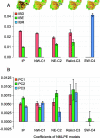Ecological, genetic and evolutionary drivers of regional genetic differentiation in Arabidopsis thaliana
- PMID: 32571210
- PMCID: PMC7310121
- DOI: 10.1186/s12862-020-01635-2
Ecological, genetic and evolutionary drivers of regional genetic differentiation in Arabidopsis thaliana
Abstract
Background: Disentangling the drivers of genetic differentiation is one of the cornerstones in evolution. This is because genetic diversity, and the way in which it is partitioned within and among populations across space, is an important asset for the ability of populations to adapt and persist in changing environments. We tested three major hypotheses accounting for genetic differentiation-isolation-by-distance (IBD), isolation-by-environment (IBE) and isolation-by-resistance (IBR)-in the annual plant Arabidopsis thaliana across the Iberian Peninsula, the region with the largest genomic diversity. To that end, we sampled, genotyped with genome-wide SNPs, and analyzed 1772 individuals from 278 populations distributed across the Iberian Peninsula.
Results: IBD, and to a lesser extent IBE, were the most important drivers of genetic differentiation in A. thaliana. In other words, dispersal limitation, genetic drift, and to a lesser extent local adaptation to environmental gradients, accounted for the within- and among-population distribution of genetic diversity. Analyses applied to the four Iberian genetic clusters, which represent the joint outcome of the long demographic and adaptive history of the species in the region, showed similar results except for one cluster, in which IBR (a function of landscape heterogeneity) was the most important driver of genetic differentiation. Using spatial hierarchical Bayesian models, we found that precipitation seasonality and topsoil pH chiefly accounted for the geographic distribution of genetic diversity in Iberian A. thaliana.
Conclusions: Overall, the interplay between the influence of precipitation seasonality on genetic diversity and the effect of restricted dispersal and genetic drift on genetic differentiation emerges as the major forces underlying the evolutionary trajectory of Iberian A. thaliana.
Keywords: Genetic diversity; Genetic structure; Iberian Peninsula; Nested maximum-likelihood population effect models; Precipitation seasonality; Spatial hierarchical Bayesian models.
Conflict of interest statement
The authors declare that they have no competing interests.
Figures




Similar articles
-
Natural genetic variation of Arabidopsis thaliana is geographically structured in the Iberian peninsula.Genetics. 2008 Oct;180(2):1009-21. doi: 10.1534/genetics.108.089581. Epub 2008 Aug 20. Genetics. 2008. PMID: 18716334 Free PMC article.
-
The genetic structure of Arabidopsis thaliana in the south-western Mediterranean range reveals a shared history between North Africa and southern Europe.BMC Plant Biol. 2014 Jan 10;14:17. doi: 10.1186/1471-2229-14-17. BMC Plant Biol. 2014. PMID: 24411008 Free PMC article.
-
Geography and Environment Shape Landscape Genetics of Mediterranean Alpine Species Silene ciliata Poiret. (Caryophyllaceae).Front Plant Sci. 2018 Nov 27;9:1698. doi: 10.3389/fpls.2018.01698. eCollection 2018. Front Plant Sci. 2018. PMID: 30538712 Free PMC article.
-
Drivers of population genetic differentiation in the wild: isolation by dispersal limitation, isolation by adaptation and isolation by colonization.Mol Ecol. 2013 Dec;22(24):5983-99. doi: 10.1111/mec.12561. Epub 2013 Nov 18. Mol Ecol. 2013. PMID: 24128305 Review.
-
Isolation by environment.Mol Ecol. 2014 Dec;23(23):5649-62. doi: 10.1111/mec.12938. Epub 2014 Oct 16. Mol Ecol. 2014. PMID: 25256562 Review.
Cited by
-
Exploring genetic diversity and phylogenetic connections of tropical bed bugs, Cimex hemipterus (F.) infestation in Indonesia.PLoS One. 2025 Jul 9;20(7):e0327540. doi: 10.1371/journal.pone.0327540. eCollection 2025. PLoS One. 2025. PMID: 40632748 Free PMC article.
-
Differential environmental and genomic architectures shape the natural diversity for trichome patterning and morphology in different Arabidopsis organs.Plant Cell Environ. 2022 Oct;45(10):3018-3035. doi: 10.1111/pce.14308. Epub 2022 Mar 27. Plant Cell Environ. 2022. PMID: 35289421 Free PMC article.
-
Natural variation in root exudate composition in the genetically structured Arabidopsis thaliana in the Iberian Peninsula.New Phytol. 2025 Feb;245(4):1437-1449. doi: 10.1111/nph.20314. Epub 2024 Dec 10. New Phytol. 2025. PMID: 39658885 Free PMC article.
-
Chromosome-Level Genome Assembly and Population Genomic Analyses Reveal Geographic Variation and Population Genetic Structure of Prunus tenella.Int J Mol Sci. 2023 Jul 21;24(14):11735. doi: 10.3390/ijms241411735. Int J Mol Sci. 2023. PMID: 37511492 Free PMC article.
-
Introduction to the Special Issue: The ecology and genetics of population differentiation in plants.AoB Plants. 2021 Sep 6;13(6):plab057. doi: 10.1093/aobpla/plab057. eCollection 2021 Dec. AoB Plants. 2021. PMID: 34804467 Free PMC article. Review.
References
-
- Barrett RDH, Schluter D. Adaptation from standing genetic variation. Trends Ecol Evol. 2008;23:38–44. - PubMed
-
- Jump AS, Marchant R, Peñuelas J. Environmental change and the option value of genetic diversity. Trends Plant Sci. 2009;14:51–58. - PubMed
-
- Hancock AM, Brachi B, Faure N, Horton MW, Jarymowycz LB, Sperone FG, et al. Adaptation to climate across the Arabidopsis thaliana genome. Science. 2011;334:83–86. - PubMed
Publication types
MeSH terms
Grants and funding
LinkOut - more resources
Full Text Sources
Other Literature Sources

